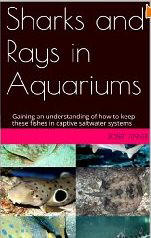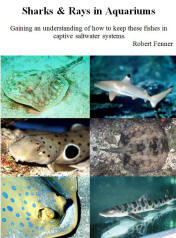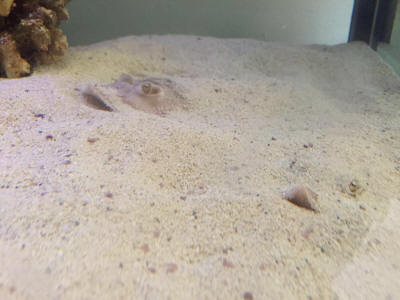|
FAQs about Rays, Skates, Guitarfishes
Behavior
Related Articles: Saltwater Ray Husbandry By Adam
Blundell, Rays, Freshwater Stingrays,
Wounds Articles, Sharks, Cartilaginous Fishes,
Related FAQs: Batoids 1, Batoids 2, Batoid Identification, Batoid Compatibility, Batoid Selection, Batoid Systems, Batoid Feeding, Batoid Disease, Batoid Reproduction, Shark, Ray Eggs, Wound Management, Freshwater Stingrays:
FW Stingray
Identification, FW
Stingray Behavior, FW Stingray Compatibility,
FW Stingray
Selection, FW
Stingray Systems, FW
Stingray Feeding, FW
Stingray Disease, FW Stingray
Reproduction,
FAQs by
groups/species: Blue Spotted
Rays,
|
%20MD.JPG)
|
 |
Sharks and Rays in Aquariums
Gaining an understanding of how to keep these fishes in captive
saltwater systems
New
Print and
eBook on Amazon
by Robert (Bob) Fenner |
 |
|
Round ray- nose tilted up 3/7/16
Dear wet web media crew, I have a couple of small round rays. They're about
5 inches in diameter. A lot of the time they like to rest with their noses
tilted up, as you can see in the image below. Is this a bad sign?
<Maybe... is this tank chilled? Urobatis concentricus. These fish are not
tropical... >
Does it mean anything and if so what could be causing this ? Both are
active, I suspect they are bullseye stingrays. They eat silversides, shrimp
and fresh marine fish once or twice a day.
<See, as in read on WWM re feeding Rays, and Thiaminase. Don't write back
till you do>
The temperature is at a steady 74 degrees
<....>
and the water parameters are good. Nitrites and ammonia at 0 and nitrates
are at 10. Thank you so much for your feedback! I look forward to hearing
from you.
<I look forward to your enlightening yourself. Bob Fenner>
|
 |
Request for bg info for my Senior Thesis Project,
Neale
12/27/10
Dear WWM Crew,
<Theresa>
Hello my name is Theresa. I'm writing to you with, what I see as an
unusual question. I'm currently doing background research for an
experiment I will be performing on 9 Cortez Round Stingrays (Urobatus
maculatus) and I'm having a very difficult time finding any
information on them. My experiment will entail working with a local
aquarium store's touch tank and the rays that are housed in it to
find a diet that will allow for a healthier living experience.
<Quite a topic! How will you assess such... healthiness?>
This research will be my Senior Thesis for my undergraduate degree in
Biology. I will be measuring Oxidative stress, Growth, Bacteria loads
on the top and bottom of the rays and well as in their feces, behavior
patterns and what they are eating.
<Wow!>
Although I do already have a good amount of research done I was
wondering if you have any peer reviewed research articles that might
help me with background information and methods for measurement.
<I do not... but having taught H.S. to college level Bio. courses,
and attended college myself for many years, and generating articles
utilizing bibliographic searches... I am aware of how to go about
looking up pertinent literature. Please read here:
http://wetwebmedia.com/litsrchart.htm and the linked FAQs file
above>
The two main sections that I need more information on is how I might
measure oxidative stress without drawing blood and without stressing
the rays out from transferring them into a holding tank and just the
basic signs of an unhealthy ray.
<The first, not able to discern w/o manipulating the specimens... as
far as I'm aware. The second; you'll have to do a bit of
reading and develop a quantitative protocol... A random revisiting
time-wise of observing the animals, counting aspects of their behavior
you determine is "health" related. Further, do investigate
common statistical methods for judging "confidence limits" on
the significance of your findings>
Thanks for your time. Sincerely Theresa
<Am going to share your mail w/ (Dr.) Neale Monks, who helps out
here as well, as he has more recently been involved w/
"doing" real science than I. Cheers, Bob Fenner>
<<Hello Theresa. As Bob says, there are a few issues here that
will need further investigation. Measuring "healthiness" is
always difficult and with fish tends to involve things like growth rate
and fecundity, things of value in aquaculture but may not be practical
here. There have been some nice works on Tetraodontiform fishes over
recent years thanks to their value in genetic research, and like your
Stingrays, these aren't easy to breed or as fast-growing as, say,
cichlids or sunfish, so they're more challenging lab animals. Do
review recent studies of Tetraodon nigroviridis and Takifugu spp. for
example. An interesting and very readable paper is "Takifugu
obscurus is a euryhaline Fugu species very close to Takifugu rubripes
and suitable for studying osmoregulation" by Akira Kato et al. One
very real problem you have is a small sample size; nine specimens may
be too small a sample for your results to have statistical
significance. In your case you might try to compensate for that by
studying the animals across a long period, arguing that growth rate is
sufficiently slow that it mightn't affect your results. If this was
me, I'd be using something I could measure very simply, for example
ventilation rate. I'd collect data at least twice per day, ideally
at least once during the resting phase and once during the active
phase. I'd collect data across several weeks, preferably 3-4
months. To ensure the data was reliable, I'd control other factors
as far as practical: temperature and water chemistry/salinity
especially. Obviously diet would need to be controlled too, because
digestion will affect the rate at which oxygen is required, if only
because fish can adjust activity rate depending on the availability of
food in their environment. Alternatively you could measure swimming
activity using a video camera to record the distances swum within a
certain randomised period, such periods taken several times per day. I
suppose it might be possible to measure oxygen concentration in the
water, and if you know the oxygen concentration in the same tank
without any fish, you might determine how much oxygen the rays were
using. But honestly, I think variation in oxygen taken up by filter
bacteria and other microbes would make this unworkable. Hope this
helps. Cheers, Neale.>>
Re: Request for bg info for my Senior Thesis Project, Neale
12/29/10
Dear Neale and Bob,
Thank you for the suggestions. I will assessing healthiness by looking
at the oxidative stress, bacteria loads, and behavior. There are three
articles done by Christina Semenuik that look at the effects of
unnatural diets on Southern Rays at the Stingray City Sandbar in the
Cayman islands.
These articles are really where I'm basing my study off of.
Semenuik found that the fatty acid profiles of the unnatural diet was
not providing the proper fatty acids to the rays, she also looked into
the costs that the group living was having on the rays themselves, and
the final study she did was on the hematological aspects such as
immunosuppressants, oxidative stress, and general health. I am unable
to draw the blood of the rays so I was hoping that looking at their
ability to ward off bacteria during different diets would show basic
health. Semenuik et al. found that the rays that were not only
unnaturally grouped but also eating unnatural diets showed higher
oxidative stress, lower general health and higher amounts of
immunosuppressants. So going off of that if the rays exhibit higher
levels of bacteria loads, and high levels of oxidative stress then the
diet currently being fed to them is not providing the proper
nutrients.
<I see. Sounds a worthy topic for investigation.>
The plan would be to study the rays once or twice a week for a month
while on one diet then at the end of the month the diet would be
changed (due to my distance from the study site and the fact that it is
a store I would be unable to take measurements everyday). As far as I
know the temperature, salinity and pH levels of the tank are controlled
as much as possible (The rays are housed in a touch tank). What do you
mean by "measure the ventilation"? Do you mean count the
amount of times that the spiracles open?
<Yes, breathing rate in fish can be estimated by counting gill
movements per minute or some similar measurement.>
Thank you for your time.
Sincerely
Theresa
Articles by Semenuik et al.
"Using Fatty-Acid Profile Analysis as an Ecologic Indicator in the
Management of Tourist Impacts on Marine Wildlife: A Case of
Stingray-Feeding in the Caribbean" "Costs of group-living for
a normally
solitary forager: effects of provisioning tourism on southern stingrays
Dasyatis americana"
"Hematological differences between stingrays at tourist and
non-visited sites suggest physiological costs of wildlife
tourism"
<Would consider doing a pilot study on something smaller, easier,
e.g., Mosquitofish that would allow easy measurements of growth rate
and fecundity, and perhaps compare these against sampled gill
ventilation rates. If you can establish that growth rate and fecundity
go down as gill movements go up, i.e., the more stressed the fish is,
the less rapidly it grows and breeds, you'd have some objective
connection between breathing rate and the healthiness of the fish
(assuming growth and fecundity are the same thing as healthiness). Or
something along these lines anyway. Cheers, Neale.>
Florida ray beh. -- 06/10/10
I have a florida ray, she is sometimes swimming in circles and lifting
her body up with her disc, what does this behavior mean?
<Mostly: "Lemme out of here!". Read here:
http://wetwebmedia.com/batoidsysfaqs.htm
and the linked files above. Likely this animal is in too small a
volume, but there are a myriad of other aquarist-caused
issues...>
She is still eating very well, does not refuse any of it.
Sent from my iPhone
<Mine from a desktop. Bob Fenner>
Research Paper on stingrays 9/9/06 Hey crew,
I'm going to be writing a research paper for my physics
class soon and I'm going to be doing it on either the Urolophus
halleri or Pteromylaeus bovinus (bull ray). I would like to know if
there is a calculation in order to calculate the rays growth a year
depending on feeding. <Mmm, not as far as I'm aware... likely
you could formulate some empirical formula here... accounting for food
volume, type, temperature, metabolite effects... much more> How many
inches do you think both of the rays grow a year? In the wild and in
public aquariums. <Age/length data exist at least for
halleri (have you seen fishbase.org re yet?> Thanks,
Ben <Bob Fenner>
Yellow Stingray Hi Bob, I
found out what that stingray was, a yellow stingray like I
thought. I would have gotten it too if I was for
sure. I was just wondering if you know how active yellow
stingrays are? Are they nocturnal? Also do you
think it would be more active then a bamboo shark? Thanks Adam Siders
<Yellow stingray? Urobatis jamaicensis?
http://www.fishbase.org/Summary/SpeciesSummary.cfm?genusname=Urobatis&speciesname=jamaicensis
Likely so... not active... spend almost entire time still, setting on
top or just under the substrate. Bob Fenner>
 |
Sharks and Rays in Aquariums
Gaining an understanding of how to keep these fishes in captive
saltwater systems
New
Print and
eBook on Amazon
by Robert (Bob) Fenner |
 |

